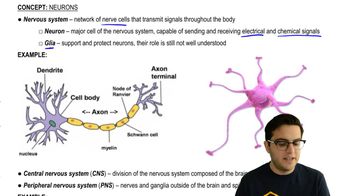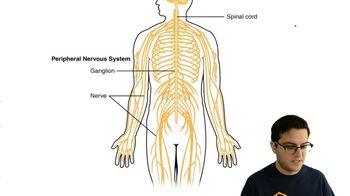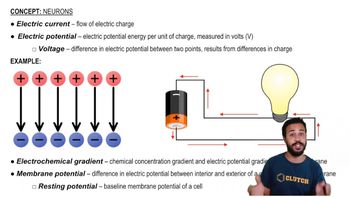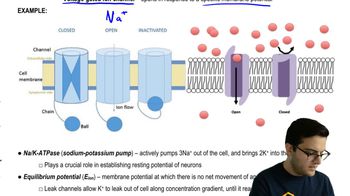Table of contents
- 1. Introduction to Biology2h 42m
- 2. Chemistry3h 40m
- 3. Water1h 26m
- 4. Biomolecules2h 23m
- 5. Cell Components2h 26m
- 6. The Membrane2h 31m
- 7. Energy and Metabolism2h 0m
- 8. Respiration2h 40m
- 9. Photosynthesis2h 49m
- 10. Cell Signaling59m
- 11. Cell Division2h 47m
- 12. Meiosis2h 0m
- 13. Mendelian Genetics4h 44m
- Introduction to Mendel's Experiments7m
- Genotype vs. Phenotype17m
- Punnett Squares13m
- Mendel's Experiments26m
- Mendel's Laws18m
- Monohybrid Crosses19m
- Test Crosses14m
- Dihybrid Crosses20m
- Punnett Square Probability26m
- Incomplete Dominance vs. Codominance20m
- Epistasis7m
- Non-Mendelian Genetics12m
- Pedigrees6m
- Autosomal Inheritance21m
- Sex-Linked Inheritance43m
- X-Inactivation9m
- 14. DNA Synthesis2h 27m
- 15. Gene Expression3h 20m
- 16. Regulation of Expression3h 31m
- Introduction to Regulation of Gene Expression13m
- Prokaryotic Gene Regulation via Operons27m
- The Lac Operon21m
- Glucose's Impact on Lac Operon25m
- The Trp Operon20m
- Review of the Lac Operon & Trp Operon11m
- Introduction to Eukaryotic Gene Regulation9m
- Eukaryotic Chromatin Modifications16m
- Eukaryotic Transcriptional Control22m
- Eukaryotic Post-Transcriptional Regulation28m
- Eukaryotic Post-Translational Regulation13m
- 17. Viruses37m
- 18. Biotechnology2h 58m
- 19. Genomics17m
- 20. Development1h 5m
- 21. Evolution3h 1m
- 22. Evolution of Populations3h 52m
- 23. Speciation1h 37m
- 24. History of Life on Earth2h 6m
- 25. Phylogeny2h 31m
- 26. Prokaryotes4h 59m
- 27. Protists1h 12m
- 28. Plants1h 22m
- 29. Fungi36m
- 30. Overview of Animals34m
- 31. Invertebrates1h 2m
- 32. Vertebrates50m
- 33. Plant Anatomy1h 3m
- 34. Vascular Plant Transport1h 2m
- 35. Soil37m
- 36. Plant Reproduction47m
- 37. Plant Sensation and Response1h 9m
- 38. Animal Form and Function1h 19m
- 39. Digestive System1h 10m
- 40. Circulatory System1h 57m
- 41. Immune System1h 12m
- 42. Osmoregulation and Excretion50m
- 43. Endocrine System1h 4m
- 44. Animal Reproduction1h 2m
- 45. Nervous System1h 55m
- 46. Sensory Systems46m
- 47. Muscle Systems23m
- 48. Ecology3h 11m
- Introduction to Ecology20m
- Biogeography14m
- Earth's Climate Patterns50m
- Introduction to Terrestrial Biomes10m
- Terrestrial Biomes: Near Equator13m
- Terrestrial Biomes: Temperate Regions10m
- Terrestrial Biomes: Northern Regions15m
- Introduction to Aquatic Biomes27m
- Freshwater Aquatic Biomes14m
- Marine Aquatic Biomes13m
- 49. Animal Behavior28m
- 50. Population Ecology3h 41m
- Introduction to Population Ecology28m
- Population Sampling Methods23m
- Life History12m
- Population Demography17m
- Factors Limiting Population Growth14m
- Introduction to Population Growth Models22m
- Linear Population Growth6m
- Exponential Population Growth29m
- Logistic Population Growth32m
- r/K Selection10m
- The Human Population22m
- 51. Community Ecology2h 46m
- Introduction to Community Ecology2m
- Introduction to Community Interactions9m
- Community Interactions: Competition (-/-)38m
- Community Interactions: Exploitation (+/-)23m
- Community Interactions: Mutualism (+/+) & Commensalism (+/0)9m
- Community Structure35m
- Community Dynamics26m
- Geographic Impact on Communities21m
- 52. Ecosystems2h 36m
- 53. Conservation Biology24m
45. Nervous System
Neurons and Action Potentials
Problem 2`
Textbook Question
A common feature of action potentials is that they
a. Cause the membrane to hyperpolarize and then depolarize
b. Can undergo temporal and spatial summation
c. Are triggered by a depolarization that reaches threshold
d. Move at the same speed along all axons
 Verified step by step guidance
Verified step by step guidance1
Understand the concept of an action potential: An action potential is a rapid rise and subsequent fall in voltage or membrane potential across a cellular membrane, typically observed in neurons.
Identify the key feature of action potentials: Action potentials are initiated when a depolarization event reaches a certain threshold level, causing voltage-gated ion channels to open.
Clarify the term 'threshold': The threshold is the critical level to which a membrane potential must be depolarized to initiate an action potential. This is a specific voltage value that triggers the opening of sodium channels.
Examine the options given: Analyze each option to determine which one accurately describes the initiation of an action potential. Focus on the role of depolarization reaching the threshold.
Conclude with the correct feature: Recognize that the correct answer is the option that describes action potentials being triggered by a depolarization that reaches threshold, as this is a fundamental characteristic of how action potentials are initiated.
 Verified video answer for a similar problem:
Verified video answer for a similar problem:This video solution was recommended by our tutors as helpful for the problem above
Video duration:
27sPlay a video:
Was this helpful?
Key Concepts
Here are the essential concepts you must grasp in order to answer the question correctly.
Action Potential
An action potential is a rapid rise and subsequent fall in voltage or membrane potential across a cellular membrane, primarily in neurons. It is initiated when a neuron receives a stimulus that causes depolarization to reach a threshold, leading to a sequence of ionic exchanges across the membrane. This process is essential for nerve signal transmission.
Recommended video:
Guided course
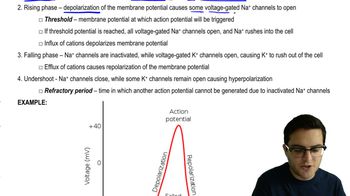
Action Potential
Depolarization and Threshold
Depolarization refers to the reduction in membrane potential, making the inside of the neuron less negative compared to the outside. When depolarization reaches a specific threshold, it triggers an action potential. This threshold is crucial as it determines whether the neuron will fire an action potential, thus playing a key role in neural communication.
Recommended video:
Guided course

Postsynaptic Potentials and Summation
Propagation of Action Potentials
Action potentials propagate along axons at varying speeds, influenced by factors such as axon diameter and myelination. Larger diameter axons and those with myelin sheaths conduct impulses faster due to reduced resistance and saltatory conduction. Understanding this variability is important for comprehending how signals are transmitted efficiently in the nervous system.
Recommended video:
Guided course

Action Potential
Related Videos
Related Practice



